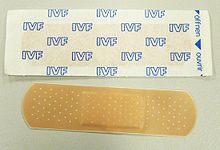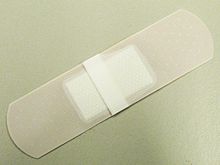First aid bandage
A rapid wound dressing ( WSV ), also known as plaster , adhesive plaster or plaster , is a piece of wound pad that is connected with an adhesive tape . It is used to cover small wounds .
history
Two people are named as inventors:
- Paul Carl Beiersdorf , patent from 1882 for the "manufacture of coated plasters".
- Earle Dickson , Johnson & Johnson employee in the 1920s. The company began to produce the plaster by machine in 1924 and continues to sell it under the Band-Aid brand to this day. The company spreads the legend that Earle Dickson's wife, Josephine, had a tendency to injure herself often while cooking. He bound strips of surgical tape together with small pieces of gauze bandages, prepared them in advance, and covered them to keep them sterile.
It is possible that first-aid bandages were used earlier, as the 15th-century painting shown here suggests.
Function and application
A first-aid bandage protects an injury to the skin (e.g. a cut ) from pathogens , mechanical loads, dirt and drying out and absorbs wound secretions or blood to a limited extent. This means that the healing process is less disturbed and the risk of infection is reduced.
It is used for smaller wounds that do not require special treatment. The wound pad covers the injury and absorbs secretions. The adhesive tape is attached to the surrounding skin and holds the overlay in the desired position.
To reduce the risk of infection, the immediate area around the wound can be treated with a disinfectant . The wound itself is only washed out with disinfectant if there is a high risk of infection, such as if rabies is suspected. The use of iodine ointment also reduces the secondary risk of infection and can make it easier to remove the patch later.
The material of the carrier material and the wound pad contained in the plaster should be selected according to the moisture level of the wound. A moist wound environment contributes to rapid healing. However, moisture penetration and swelling of the surrounding tissue due to excessive moisture accumulation should be avoided. By changing the patch regularly, residues and dead skin are removed and the moisture content of the wound can be estimated.
material
Depending on the area of application, the adhesive tape consists of a special fabric or plastic with a more or less strongly adhesive coating.
The wound dressing is usually absorbent and often prepared with antibacterial substances . Some manufacturers use a special coating to ensure that the pad does not stick to the wound.
dimension
First-aid dressings are usually supplied in widths of 2.5, 4, 6 and 8 cm and lengths between 25 and 500 cm for cutting, which allows more flexible use than the more and more popular strips in recent years - prefabricated, individually packaged strips in various shapes for wounds of different sizes.
The dimensions of first aid bandages are standardized in Germany in DIN 13019.
Further areas of application
In addition to the function as a pure wound dressing, there are plasters for the following applications:
- Administration of drugs - transdermal patches (e.g. nicotine patches , hormone patches )
- Absorption of wound secretion - gel plaster
- Padding or pressure relief - blister plasters , plasters for corns
- Prevention of the spread of viruses (also protection against drying out) - herpes plasters
- Calming pain and promoting blood circulation - heat patches
- Enlargement of the ala - nasal patches
- For the closure of small, superficial wounds can clip paving (also, wound closure strips Steri-strips) are used. They are particularly suitable for children as an alternative to sutures.
See also
Individual evidence
- ↑ Entry wound plaster , online Duden, accessed on May 1, 2020.
- ^ Entry wound plaster , DWDS, accessed on May 1, 2020.
- ^ Entry Heftpflaster , Online-Duden, accessed on May 1, 2020.
- ^ Entry of adhesive plaster in the DWDS
- ↑ Entry Heftpflaster , Online-Pschyrembel, accessed on May 1, 2020
- ↑ Chronology of Beiersdorf AG on the company's website. Retrieved January 3, 2015 .
- ↑ Carola Zinner: Patent on the coated plaster. Bayerischer Rundfunk, March 28, 2012, accessed on July 17, 2012 .
- ↑ Band-Aid Brand Heritage . Retrieved May 12, 2017.
- ↑ Irene Berres: Myth or Medicine - Do wounds need air or plasters? , Spiegel Online, September 9, 2013
- ↑ Wolfgang Vanscheidt: Wound healing - moist is better , Pharmazeutische Zeitung, issue 29/2010
- ↑ a b S1 guideline for wounds and wound treatment of the German Society for Pediatric Surgery (DGKCH). In: AWMF online (as of 2014)
- ↑ a b Doris Henne-Bruns, Michael Dürig, Bernd Kremer (Eds.): Duale Reihe - Chirurgie . 3., completely revised. and exp. Edition Thieme, Stuttgart 2007, ISBN 978-3-13-125293-7 , pp. 156 .
- ↑ Elfriede Nusser-Rothermundt: Wundschnellverband. In: Pschyrembel Online. Walter de Gruyter GmbH, May 4, 2015, accessed on February 12, 2018 .



